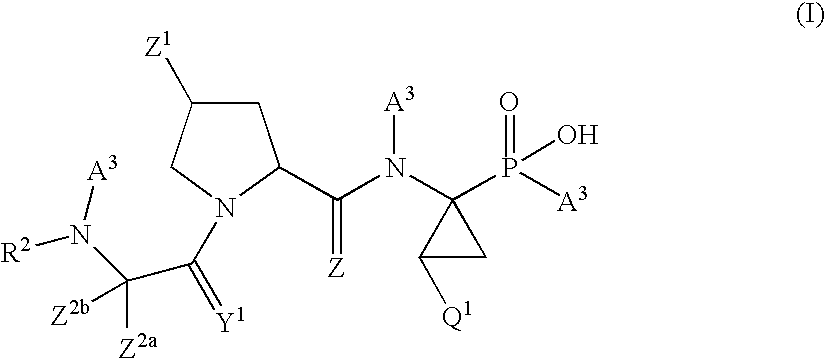Antiviral phosphinate compounds
- Summary
- Abstract
- Description
- Claims
- Application Information
AI Technical Summary
Benefits of technology
Problems solved by technology
Method used
Image
Examples
example 1
Preparation of Compound 1
[0384]
[0385] Phosphonic acid intermediate (1-benzyloxycarbonylamino-2-vinyl-cyclopropyl)-phosphonic acid monoethyl ester III (415 mg, 1.28 mmol) was dissolved in toluene (8 mL). This solution was cooled to 0° C. and (COCl)2 (222 μL, 2.56 mmol) was added in a drop-wise fashion. DMF (44 μL, 0.56 mmol) was then added. The reaction was run for 2 h at 0° C. and determined to be complete by 31P NMR. 31P NMR (121.4 MHz, CDCl3): δ 39.0, 38.5, 37.4, 36.5, 17.0, 16.2, 16.0, 15.4.
[0386] The reaction was concentrated to orange-yellow oil and then placed under high vacuum for 1 h. The resulting residue was dissolved in THF (6.4 mL) and this solution was cooled to −78° C. A 1.4 M solution of methyllithium in diethyl ether (1.37 mL, 1.92 mmol) was added drop-wise. After 40 min, more methyllithium (456 μL, 0.64 mmol) was added drop-wise. After 10 min, the reaction was quenched at −78° C. by the addition of sat. NH4Cl (aq.). The organic phase was diluted with EtOAc and extr...
example 2
Preparation of Compound 2
[0389]
[0390] Phosphonic acid intermediate III (208 mg, 0.64 mmol) was dissolved in toluene (8 mL). This solution was cooled to 0° C. and (COCl)2 (111 μL, 1.28 mmol) was added in a drop-wise fashion. DMF (22 μL, 0.28 mmol) was then added. The reaction was run for 2 h at 0° C. and determined to be complete by 31P NMR.
[0391]31P NMR (121.4 MHz, CDCl3): δ 39.0, 38.5, 37.4, 36.5, 17.0, 16.2, 16.0, 15.4.
[0392] The reaction was concentrated to orange-yellow oil and then placed under high vacuum for 1 h. The resulting residue was dissolved in THF (6.4 mL) and this solution was cooled to −78° C. A solution of EtLi in dibutyl ether (1.7 M, 566 μL, 0.96 mmol) was added drop-wise. After 40 min, more EtLi (189 μL, 0.32 mmol) was added drop-wise. After 10 min, the reaction was quenched at −78° C. by the addition of sat. NH4Cl(aq.). The organic phase was diluted with EtOAc and extracted with sat. NH4Cl(aq.) and brine. The organic phase was dried over MgSO4. Concentration ...
example 3
Preparation of Compound 3
[0395]
[0396] Phosphonic acid intermediate III (386 mg, 1.19 mmol) was dissolved in toluene (14.9 mL). This solution was cooled to 0° C. and (COCl)2 (155 μL, 1.78 mmol) was added in a drop-wise fashion. DMF (20 μL, 0.26 mmol) was then added. The reaction was run for 2 h at 0° C. and determined to be complete by 31P NMR. 31P NMR (121.4 MHz, CDCl3): δ 39.0, 38.5, 37.4, 36.6, 17.0, 16.2, 16.1, 15.4.
[0397] The reaction was concentrated to a yellow-orange oil and then placed under high vacuum for 1 h. The resulting residue was dissolved in THF (11.9 mL) and this solution was cooled to −78° C. A 2.0 M solution of n-BuLi in pentane (595 μL, 1.19 mmol) was added drop-wise. After 40 min more n-BuLi (520 μL, 1.04 mmol) was added drop-wise. After 10 min the reaction was quenched at −78° C. by the addition of sat. NH4Cl(aq.). The organic phase was diluted with EtOAc and extracted with sat. NH4Cl(aq.) and brine. The organic phase was dried over MgSO4. Concentration of th...
PUM
| Property | Measurement | Unit |
|---|---|---|
| Composition | aaaaa | aaaaa |
| Structure | aaaaa | aaaaa |
| Pharmaceutically acceptable | aaaaa | aaaaa |
Abstract
Description
Claims
Application Information
 Login to View More
Login to View More - R&D
- Intellectual Property
- Life Sciences
- Materials
- Tech Scout
- Unparalleled Data Quality
- Higher Quality Content
- 60% Fewer Hallucinations
Browse by: Latest US Patents, China's latest patents, Technical Efficacy Thesaurus, Application Domain, Technology Topic, Popular Technical Reports.
© 2025 PatSnap. All rights reserved.Legal|Privacy policy|Modern Slavery Act Transparency Statement|Sitemap|About US| Contact US: help@patsnap.com



